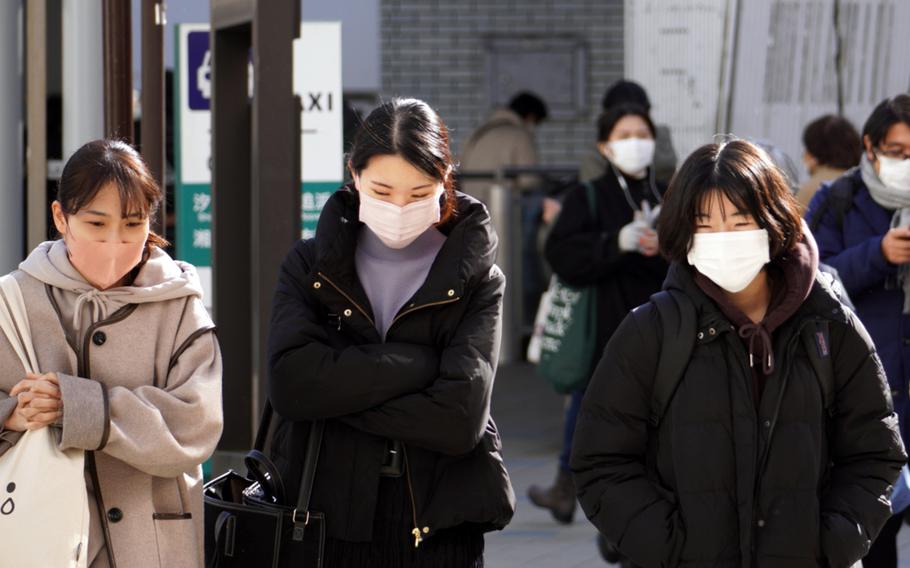
Tokyo reported a new one-day high of 14,086 coronavirus infections on Wednesday, Jan. 26, 2022. (Akifumi Ishikawa/Stars and Stripes)
Stars and Stripes is making stories on the coronavirus pandemic available free of charge. See more stories here. Sign up for our daily coronavirus newsletter here. Please support our journalism with a subscription.
TOKYO — The sixth wave of COVID-19 in Japan’s capital city gave no indication it may crest soon as new case numbers soared even higher Wednesday.
Tokyo reported 14,086 new infections, nearly 1,300 more than the previous record set Tuesday, according to public broadcaster NHK.
Hospitalizations have steadily increased, a major cause for concern by public health officials. About 40% of beds available for COVID-19 patients were filled Tuesday, but just 2.5% of those for severely ill patients, according to the metro government.
Meanwhile, new case numbers at U.S. military bases fell for a third consecutive day. U.S. Forces Japan in a Wednesday update said 172 people had tested positive at 13 installations since the previous day; one person was awaiting confirmation. That number is down from 261 reported Monday and 810 on Jan. 12.
None of the U.S. military cases are hospitalized or seriously ill, according to USFJ.
Yokosuka Naval Base, homeport for the U.S. 7th Fleet south of Tokyo, topped the list for a second day with 60 new infections. Eight locations reported no confirmed cases.
U.S. Army Japan, headquartered at Camp Zama southwest of Tokyo, had 101 new COVID-19 infections for a seven-day period ending Wednesday, according to an Army news release. Of those, 53 were close contacts, 38 had fallen ill, five were in restricted movement and three were tested upon arriving in Japan.
Sasebo Naval Base, on Kyushu island, reported 36 people have tested positive since Tuesday, according to a Wednesday post on its Facebook page. The base has 253 active cases.
Marine Corps Station Iwakuni, south of Hiroshima, on Wednesday said 17 people tested positive the previous day, according to a news release.
In a report released Tuesday, the U.S. Centers for Disease Control and Prevention confirmed what health professionals and the media have widely reported: The omicron variant, while generating record infection numbers, has yielded proportionately fewer hospital admissions, emergency room visits and deaths than previous coronavirus variants.
During the omicron wave, “disease severity indicators, including length of stay, [intensive care unit] admission, and death, were lower than during previous pandemic peaks,” according to the report summary.
Also, this week the U.S. State Department issued a travel advisory, cautioning Americans to reconsider their trips to Japan, a country that won’t admit most of them, anyway.
The State Department level 3 travel advisory for Japan cites the CDC, which issued its own Level 3 Travel Health Notice due to Japan’s high COVID-19 levels.
Japan’s record-breaking wave of new COVID-19 cases are double the one-day records set in August, according to the World Health Organization. The Johns Hopkins Coronavirus Resource Center, which tracks the pandemic worldwide, put Japan’s new case numbers at 62,489 on Tuesday, another record high.
Conversely, Japan closed its borders to new arrivals Dec. 2 citing an uptick in COVID-19 cases that grew into the current wave. The government at the time rolled back plans to admit some business travelers and international students.
Travelers from the United States were already on Japan’s list of those to be denied entry, according to the Foreign Ministry. The U.S. has company; most of the world’s countries are on that list.
Individuals under the status of forces agreement are an exception; they may come and go from Japan with permission from the U.S. military. SOFA outlines the rights and responsibilities of the U.S. military population in Japan.
The U.S. military in Japan passed another day Wednesday of a three-week restriction order due to expire Monday. Service members, civilian employees and their families are restricted to their installations, or their off-base homes, with exceptions for visits to grocery stores, medical and veterinary appointments and houses of worship, among others. The order came with a 10 p.m. to 6 a.m. curfew and a widespread mask mandate.